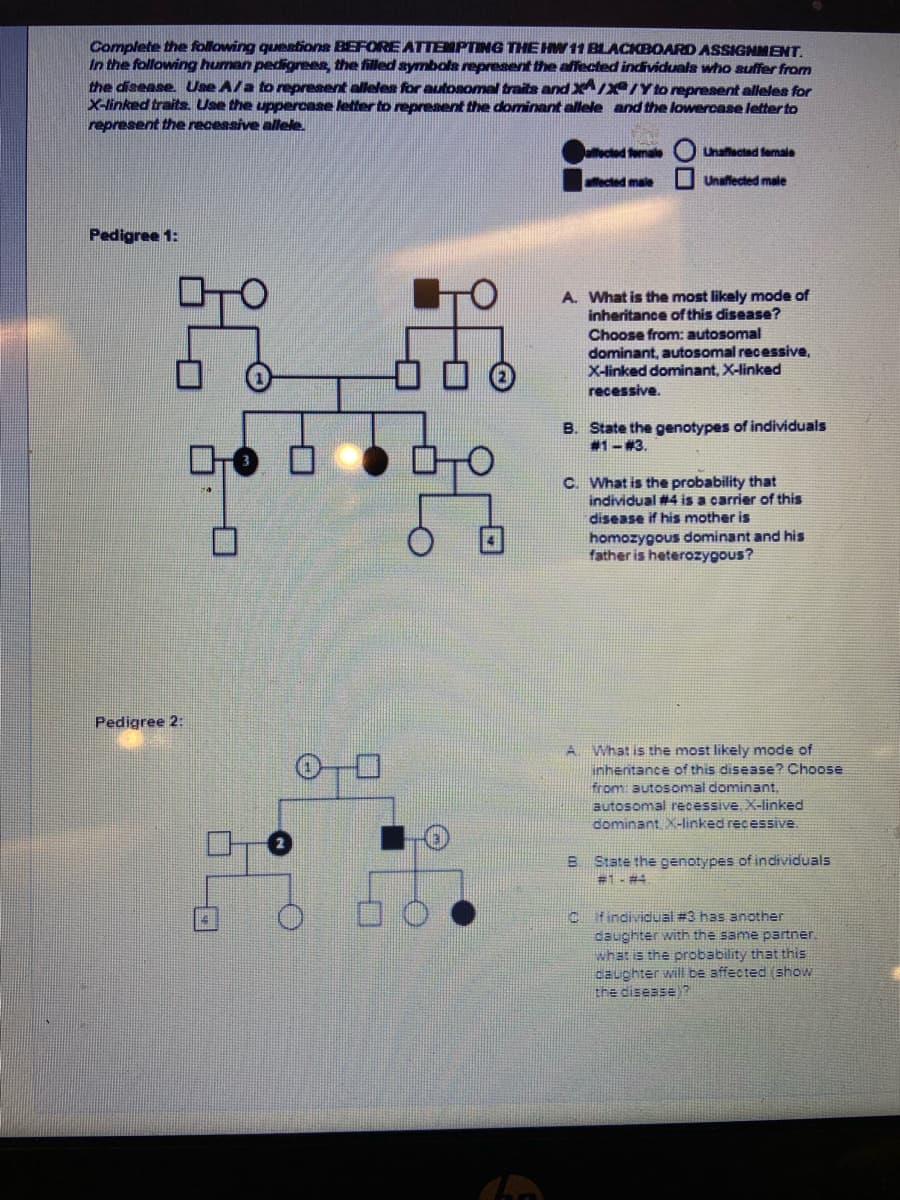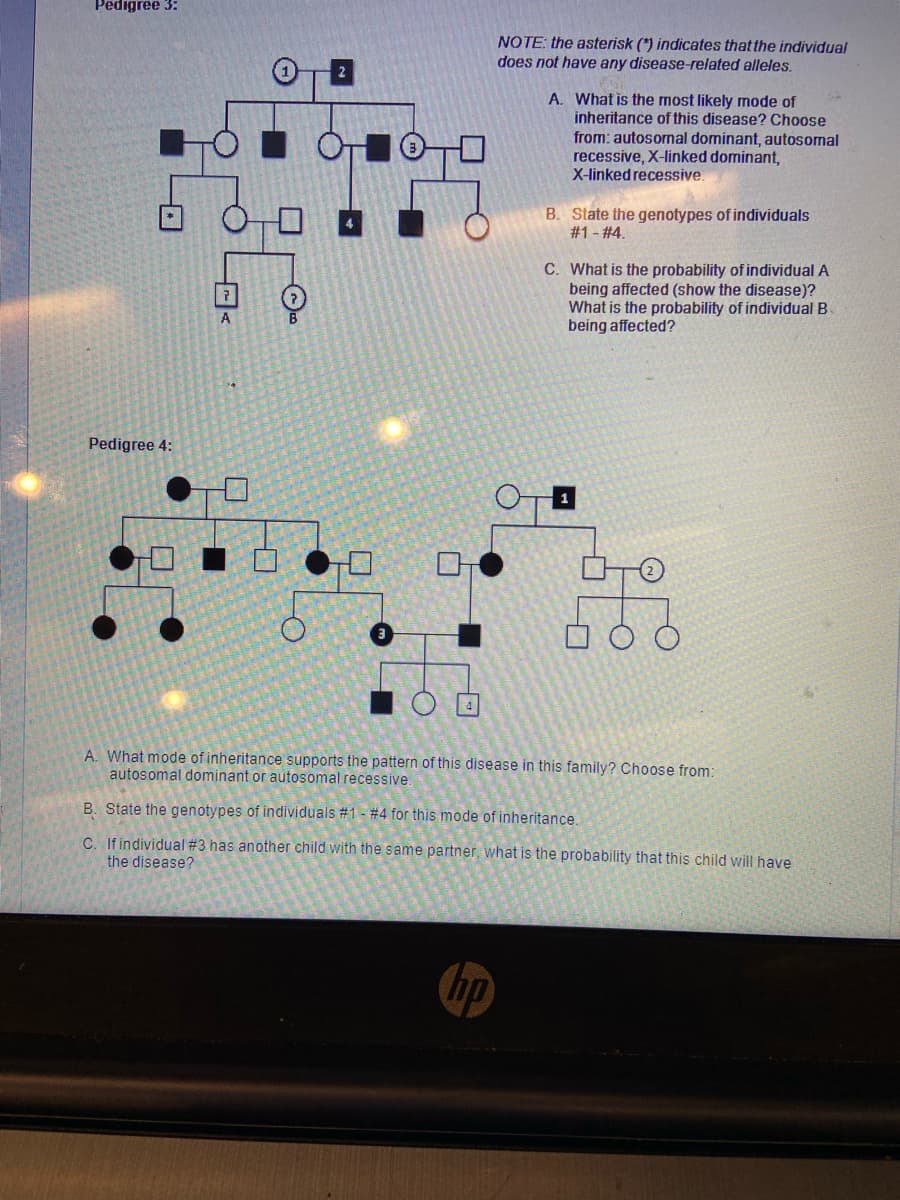Pedigree 1: A. What is the most likely mode of inheritance of this disease? Choose from: autosomal dominant, autosomal recessive, X-linked dominant, X-linked recessive. B. State the genotypes of individuals #1-#3. C. What is the probability that individual #4 is a carrier of this disease if his mother is homozygous dominant and his father is heterozygous?
Pedigree 1: A. What is the most likely mode of inheritance of this disease? Choose from: autosomal dominant, autosomal recessive, X-linked dominant, X-linked recessive. B. State the genotypes of individuals #1-#3. C. What is the probability that individual #4 is a carrier of this disease if his mother is homozygous dominant and his father is heterozygous?
Human Heredity: Principles and Issues (MindTap Course List)
11th Edition
ISBN:9781305251052
Author:Michael Cummings
Publisher:Michael Cummings
Chapter4: Pedigree Analysis In Human Genetics
Section: Chapter Questions
Problem 7QP: Use the following information to respond to the three questions posed below: (1) The proband...
Related questions
Topic Video
Question

Transcribed Image Text:Complete the following queatione BEFORE ATTEMPTING THE HW 1 BLACKBOARD ASSIGNMENT,
In the following human pedigrees, the filled symbols represnent the affected individuals who suffer from
the disease. Use A/a to represent alleles for autosomal traits and XIX/Ytorepresent alleles for
X-linked traits. Use the uppercase letter to represent the dominant allele and the lowercase letterto
represent the receasive allele.
afected fomale
Unafected female
affected male
Unaffected male
Pedigree 1:
A. What is the most likely mode of
inheritance of this disease?
Choose from: autosomal
dominant, autosomal recessive,
X-linked dominant, X-linked
recessive.
B. State the genotypes of individuals
#1-#3.
C. What is the probability that
individual #4 is a carrier of this
disease if his mother is
homozygous dominant and his
father is heterozygous?
Pedigree 2:
What is the most likely mode of
inhentance of this disease? Choose
from: autosomal dominant,
autosomal recessive X-linked
dominant X-linked recessive.
B State the genotypes of individuals
=1-#4
findividual #3 has another
daughter with the same partner.
what is the probability that this
caughter will be affected (show
the disease?

Transcribed Image Text:Pedigree 3:
NOTE: the asterisk (*) indicates that the individual
does not have any disease-related alleles.
A. What is the most likely mode of
inheritance of this disease? Choose
from: autosomal dominant, autosomal
recessive, X-linked dominant,
X-linked recessive.
B. State the genotypes of individuals
#1 - #4.
C. What is the probability of individual A
being affected (show the disease)?
What is the probability of individual B
being affected?
A.
Pedigree 4:
A. What mode of inheritance supports the pattern of this disease in this family? Choose from:
autosomal dominant or autosomal recessive.
B. State the genotypes of individuals #1 - #4 for this mode of inheritance.
C. If individual #3 has another child with the same partner, what is the probability that this child will have
the disease?
hp
Expert Solution
This question has been solved!
Explore an expertly crafted, step-by-step solution for a thorough understanding of key concepts.
This is a popular solution!
Trending now
This is a popular solution!
Step by step
Solved in 2 steps

Knowledge Booster
Learn more about
Need a deep-dive on the concept behind this application? Look no further. Learn more about this topic, biology and related others by exploring similar questions and additional content below.Recommended textbooks for you

Human Heredity: Principles and Issues (MindTap Co…
Biology
ISBN:
9781305251052
Author:
Michael Cummings
Publisher:
Cengage Learning

Human Heredity: Principles and Issues (MindTap Co…
Biology
ISBN:
9781305251052
Author:
Michael Cummings
Publisher:
Cengage Learning